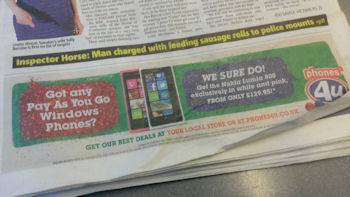Review: HTC Windows Phone 8X - hardware
While much of the media attention might be focussed on the Nokia Lumia 920, the other flagship smartphone is quietly gathering fans and network support. HTC are no stranger to Windows Phone, and have promised to put some significant corporate spending behind their Windows Phone 8 devices. Microsoft have anointed the HTC Windows Phone 8X as a signature Windows Phone device, to be used by themselves while promoting the platform. That's the handset we're going to look at now. Over the next few weeks we'll look at the HTC 8X in some depth alongside our coverage of the Windows Phone 8 platform.
Version Reviewed: Retail
Introduction
Apart from the clunky name (which everyone is shortening to HTC 8X, so we'll do the same in this review), the handset is as cutting edge as possible. It has to be, because HTC have not had a pretty year. Their leading Windows Phone 7.5 device, the Titan 2, was lost in the accolade around the US launch of the Lumia 900. Their signature range of Android devices, the 'One' range have not arrested the supremacy of the Samsung Galaxy handsets. They don't have another consumer electronics area, or a range of feature phones, to fall back on. HTC are in a the middle of a very efficient squeeze. The 8X is their answer to those conditions, and it's a powerful answer. Along with the HTC 8S, the Taiwanese firm is making a strong claim to be considered the leading Windows Phone 8 manufacturer.

In the box
The initial retail experience of the HTC 8X is not that stunning. Shipping in a rather weak feeling cardboard box (presumably recycled and recyclable), a simple white paper slip goes around the off-white cardboard to identify the phone inside. The box itself is incredibly rounded, along all the corners and edges. It's a nice piece of construction, but in terms of design and promise it does not serve the 8X well. It deforms slightly in the hand, and for a flagship smartphone we'd expect something more than a 'pile em high' ethos in the packaging.
Inside, the 8X is presented on a tray under the lid, and under this can be found the paperwork, getting started pamphlets, and a SIM removal tool. Much like the iPhone has, you'll need to push in a small paperclip sized spike to open the micro-SIM tray on the side of the 8X. Under the paperwork, you have a micro-USB cable, AC charger, and a pair of in-ear headphones. These also double up as a hands-free kit, with a single button remote controller. The sound reproduction, as you would expect from a bundled headset, is OK, but there's plenty of room for improvement. Once we've listened to some more music and tried the Beats Audio system, we'll let you know, but the suspicion is that audiophiles will skip over these cans and move onto their own favoured headsets.
As for the single button, there is no literature in the box on what the button does, nor is there on the phone. Most people will assume that it can be used to answer and end calls, but the fact that it doubles as a play/pause button during music playback is less obvious. Perhaps we're old fashioned, but there's a blank page in the getting started guide that could have featured the headset. Even a single page insert would have been welcome.
Design and materials
The HTC 8x has a fascinating shape. The hardware design process has placed the thicker components towards the centre of the smartphone, allowing the rear of the unit to have a graceful curve up to meet the edges of the unit. The screen is flat, but with very slightly curved edges that meet the bezel, which continues down to meet the same edge as the curve from the rear. This happens on all four edges. While the central spine of the HTC 8X checks in at around 10mm thick, about a third of the overall footprint is less than this, leading to a very interesting physical illusion of thinness. In the hand, the phone feels much thinner than it actually is.
As Rafe explained in our preview of the HTC 8X, the design has been inspired by Windows Phone's Live Tiles:
In design terms, HTC decided to start from a blank piece of paper. While there are obviously design cues from other HTC devices, most notably the Android-powered One series, the company deliberately decided to give its Windows Phone 8 devices a distinctive character, recognising that a single design cannot serve all platforms.
The inspiration for the 8X's overall design shape was the idea of a live tile drawn out of the Windows Phone Start screen and then inflated like a cushion, giving the distinctive tapered edges. From a technical point of view this is a challenging design to implement because it is necessary to place the thicker components towards the centre of the device, thus adding an additional design constraint.
The issue with this design is that it does lead to some rather thin edges. Not razor blade thin you understand, and bevelled so it's comfortable on the skin, but enough to provide a distinctive tactile feel. It does take some getting used to and reminds me of a hardback book, where the cover reaches past the pages slightly. But hardback books don't have volume controls on the edges, ready to be pressed when you hold the HTC 8X in too hard a grip. The pressure needed on the volume, power, and camera keys along the edges is not insubstantial, but it's still rather light, which leads to a lot of accidental button presses. And because the buttons are almost flush with the side of the device, it's not as easy to find and press them when you mean to.

The positioning of the power/lock button on the top of the device is standard for HTC, but it's not as convenient as the side positioning found on other devices. While the top position is a more natural location for the power button, the side position makes it easier to lock and unlock the device with one hand, something that's a much more common occurrence than powering the handset on or off.

Turn the 8X over and you'll find the camera lens. It's very slightly recessed away from the body, although this is a distinction that's hard to confirm this visually you can feel the ridge under your fingers. There's nothing to draw attention to the camera, which is in keeping with the sleek lines of the rest of the devices, and this layout is more attractive that the camera bumps found on some of HTC's other devices, such as the One X.

HTC are to be congratulated that they have created a unique design that you don't immediately think "this is like everything else in the shop". It means that even though this is one of the larger smartphones on the market, it sits easily in the hand. The addition of a bumper case is sure to spoil all of that, but in its naked form the overall form of the 8X is a stunning piece of design. The only time it doesn't really work is when the 8X has been placed screen side down... it's a little awkward to get a good grip and pick up the handset when this happens.
The idea of being pleasingly-tactile and having a distinctive feel carries on to the coating on the 8X's body shell, which HTC refer to as soft touch. Like the Nokia's Lumia devices, each HTC 8X is shaped from a single block of coloured polycarbonate to create the unique shape discussed above. Right now it feels a little powdery to the touch, but it's a high-friction coating that grips the skin of the hand relatively well when giving it a little shake to see if it stays or slips. Our review unit was the Graphite Black colour variant, but HTC are offering a number of other options. The Limelight Yellow and Flame Red variants are particularly striking, but our personal favourite is the California Blue. Do note that not all colours are available on all networks.
So, in terms of the big picture the design is a winner, but there are some small touches that give cause for concern. Let's start with the alert/charging light. This appears to be a red LED on the circuit board, that shines through a small lens just behind the earpiece above the screen. That earpiece has a line of small holes punched out, and the LED shines through a few of them. It keeps catching the eye, leading us to wonder if something is missing, because the expectation is to see a solid block of light. What is on show feels like the designers who worked on the case weren't around when deciding what to do with the alert light, thus the Heath Robinson effect created. That doesn't say 'flagship'.
The loudspeaker grille, for handsfree calling and media playback sans headphones, is also on the back of the smartphone. With a speaker grille of tiny holes drilled directly through the polycarbonite casing but no extra plastic facade, it blends in far more than the earpiece on the front of the 8X.
Unfortunately, when you place the 8X down on a desk, the speaker holes are covered up, changing the tone of the music to something a little more tinny, squishing out many of the midtones and bass lines. Naturally there's a trade off at play here, the speaker is a substantive part of the design and needs to stay in the central spine of thick equipment, but at the same time the direction of the sound is not optimal. We really noticed this when playing arcade games that needed both thumbs on the screen. The speaker wasn't covered, but as our hands moved around, the sound quality was altered, making for a slightly frustrating audio experience.

The headphone jack is a 3.5mm design, and takes a standard headphone cable, but also headset kits with the extra input ring on the jack plug and conforming to the AHJ (think iPhone) control standard. Because of the curved design, part of the metal of the jack plug is left exposed. This doesn't change the electrical connection, but again it's something that doesn't look elegant. There's also a question around extra impact damage if the phone hits the ground on a jack. That could impart a bit more 'twist' onto the motherboard because of the effect of a 'splint' on one side of anything plugged in.
Design is an important part of the smartphone process just now, and overall HTC have done a cracking job in making the 8X stand out from the crowd. Certainly in Europe HTC is not held in as high regard as some other manufacturers, so making a desirable handset is key to the 8X's success. That's why the small touches around the LED light, side buttons, and the loudspeaker are so disappointing. HTC are close, but just miss giving us a perfect impression of the 8X. It's almost as if too much weight was put on getting the perfect shape, and not quite enough on practical usage. It should be acknowledged that this is an area of intense debate. Many will prefer a device that puts more emphasis on design and styling, but others, most notably power users, will wonder if a little too much has been sacrificed to achieve this.
Size and weight
The HTC 8X manages to be incredibly average in the size and weight department. That's a good thing, because it simply casts it as a regular phone. Not too heavy (130 grams, 86cc) and not too big (132.4 x 66.2 x 10.1 mm), it sits in the middle when you list it with other smartphones of today.
| Device | Size (mm) | Volume (cc) | Weight (g) |
| HTC 8X | 132.4 x 66.2 x 10.1 | 86 | 133 |
| Nokia Lumia 920 | 130.0 x 70.8 x 10.7 | 99 | 185 |
| HTC TITAN | 131.5 x 70.7 x 9.9 | 92 | 160 |
| HTC HD2 | 120.5 x 67 x 11 | 89 | 157 |
| Lumia 800 | 116.5 x 61.2 x 12.1 | 76 | 142 |
| HTC One X | 134.4 x 69.9 x 8.9 | 84.4 | 130 |
| Samsung Galaxy S III | 136.6 x 70.6 x 8.6 | 82.2 | 133 |
| Apple iPhone 5 | 123.8 x 58.6 x 7.6 | 76 | 112 |
Without any standout points one way or another, HTC have made sure the 8X will be considered as a suitable smartphone. While people will focus on the size of their mobile devices, the smart styling and the curves that are part of the design do make the 8X look and feel smaller than it actually is. People will still be picking up the large screen, but at the same time next to a Galaxy or a Lumia, the 8X is going to be perceived as being small and 'jam packed' giving it an advantage on the sales floor that is easy to understand. Nobody can argue that 130 grammes is heavy, when it matches HTC's One X smartphone, and is a shade lighter than Samsung's Galaxy S III.

In terms of construction, the HTC 8X feels strong, but not indestructible. While the build quality is excellent, it is possible to flex the entire device, in a way that's not possible with the much denser Lumia 920. Once you pass a 4 inch dimension on the screen, smartphones start to look fragile and you don't feel they would survive any decent impact with the ground. The fact is they do, countless times, and perhaps it's unfair to criticise the 8X here without comprehensive testing, but of the larger smartphones we've used, the 8X does feel more likely to ding itself when gravity takes over. In particular, we wonder how well the crisp edges on the handset will stand up to the multiple impacts that are likely to occur over two years of use.
The HTC 8X sports an 1800mAh battery, which puts it 10% down in terms of capacity on the Lumia 920, and 22% down on the Samsung ATIV S's 2300mAh monster. Being a unibody construction, there's no user-replaceable battery here. We'll need to use the handset a bit more to get a clear idea how well this copes with day to day usage, but right now you should be looking to do a precautionary top up before finishing any office work and heading out for a night on the town.
US network Verizon's announcement that they would have the exclusive deal on 8X units with Qi wireless charging is interesting, and shows that HTC have the capability to add this to the handset. Unfortunately, our review units are all UK models, so we can't compare the charging to other handsets with similar technology.
Screen
Protected by Corning Gorilla Glass, the HTC 8X's screen packs 1280 x 720 pixels into its 4.3 inch display. That's 341 pixels per inch, one of the highest available of any smartphone. It's certainly well past the point where the human eye can detect individuals pixels and you'll struggle to do so even with an average magnifying glass. The 8X's display is optically laminated to the rest of the screen stack (glass), which gives added vibrancy, superior viewing angles, cuts down on reflections, and makes it appear as if the screen is floating on the glass layer.
Outdoors visibility, in bright sunlight, is good, comparable to the iPhone 5, though not as good as recent Nokia devices, especially those devices with the adaptive image contrast technology. The non-pentile SUPER LCD 2 display that HTC is using is of high quality, but blacks do feel a little washed out. That's to be expected in a comparison with an AMOLED screen, but there's also a visible difference when compared to the IPS LCD-equipped Nokia Lumia 920. With the default Windows Phone UI heavily reliant on black, it's more of an issue than with HTC's Android devices.
Neither the outdoors visibility or blacks mean the HTC 8X's screen is bad. In truth, it's being rather picky to highlight these areas, and it's only fair to note that in some areas, such as viewing angle, the HTC 8X outshines most of its competition. However, while it's true to say many of the differences can only be fully appreciated in a direct comparison, it's likely that those switching from specific devices and/or technologies will be aware of the difference (e.g. blacks in AMOLED to Super LCD 2, outdoors visibility in Nokia's ClearBlack Display to HTC's optical screen lamination).
Looking only at the Windows Phone side of things, there's one area that's not been much remarked upon, but is, perhaps, of greater importance than any of the factors mentioned above when deciding which device to buy. And that area is the aspect ratio of the screen.
Windows Phone 8 introduced two new screen resolutions: 1280x768 and 1280x720. The first of these, used by Nokia in the Lumia 920, has the same aspect ration (15:9) as all the Windows Phone 7 devices (480x800). However, the second, as used by HTC in the 8X and Samsung in the ATIV S, has an aspect ratio of 16:9.
Windows Phone 8 automatically handles scaling of the UI and is aided in this by the fact that Windows Phone's developer environment does not encourage apps to lock to a specific resolution. We've yet to come across any app that has an issue going from 480x800 to 1280x768, but the change in aspect ratio does introduce an additional challenge when moving from 480x800 to 1280x720. Many apps, including all the built in ones, handle this challenge with grace. The width is used as the scaling constraint, which means the 16:9 screens will actually show more information than the 15:9 screens, and their on screen elements will also be proportionally smaller (a standard Live Tile is 315x315 at 16:9 and 336x336 at 15:9).
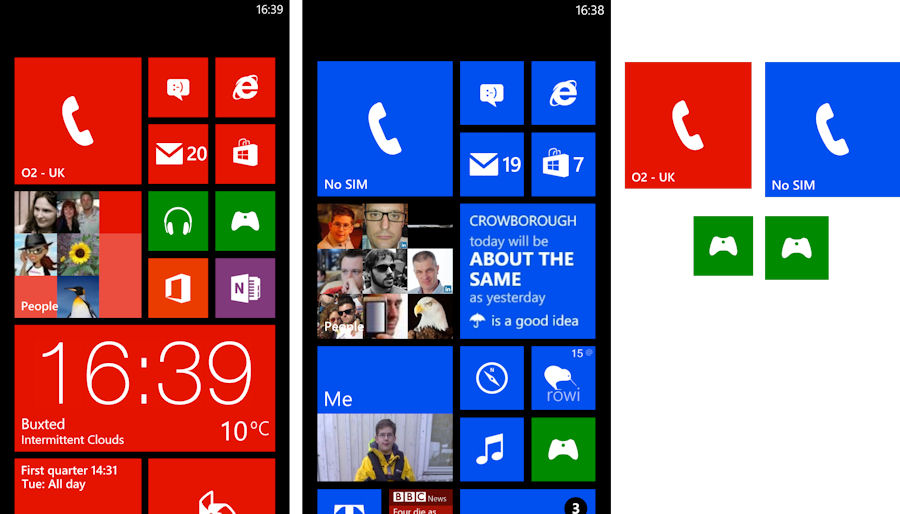
16:9 (left, HTC 8X) compared to 15:9 (right, Nokia Lumia 920)
However, in some third party apps there are portions of unused screen space. This usually takes the form of a black bar running near the top of the screen. Thanks to the chromeless nature of the Windows Phone UI it's not immediately noticeable at first, but once you do start noticing it, it's difficult to ignore. The degree of annoyance will depend on what and how many third party apps you use (and to what extent). This will vary from person to person, and obviously the issue can, in most cases, be solved by a simple app update. However, fixing all the third party apps that have this issue may take time, so it is an important factor to account for in the purchase equation.
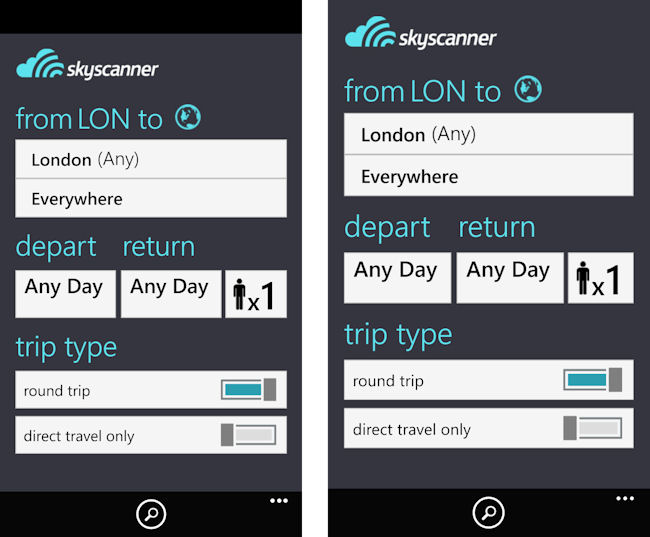
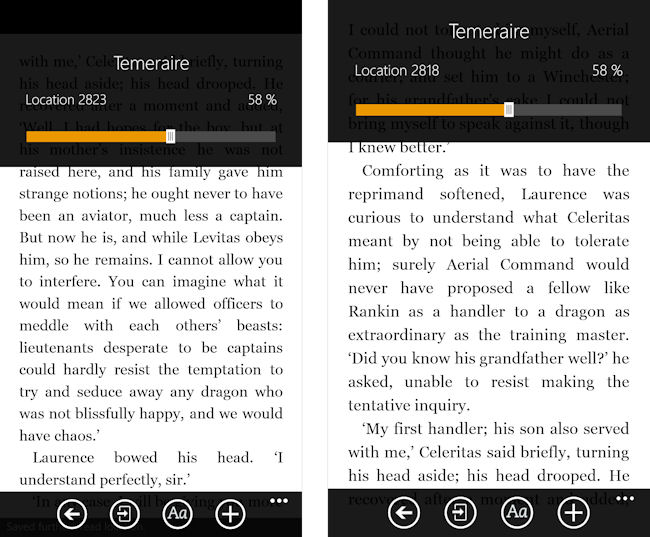
Third party apps with black bar at the top (HTC 8X left, Lumia 920 right)
There's a secondary effect of the aspect ratio that's well worth mentioning too. Those devices with the 16:9 ratio, like the HTC 8X, are proportionally narrower and longer than those devices with a 15:9 ratio. A narrower device is easier to hold one handed, but the top of the screen is harder to reach with a taller device. Once a device is beyond the boundary of universal one-hand usage, generally considered to be a width of 60mm or less, our view is that width become less important than height, which means, for devices with screens over 3.8 inches in size, we would generally favour a 15:9 screen over a 16:9 screen, but this is a largely subjective opinion.
Camera
HTC have fitted the 8X with the same 8 megapixel camera module, and associated ImageChip technology, as they used in their Android-powered One X. As you might expect, the base line performance is very similar, but there are some differences as HTC has not implemented its full range of ImageSense use cases (e.g. HDR, burst, panorama modes). All of these could be added through Windows Phone 8's camera app lenses functionality, but, rather disappointingly, at the time of writing, none of them were available.
As we noted in our Nokia Lumia 920 review, most of the leading smartphones have cameras with similar core specifications, and consequently have similar performance. The HTC 8X's Backside Illuminated (BSI) 8.0 megapixel sensor is standard, but it does stand out a little from the pack thanks to its F2.0 and ImageChip image processing chip. The first of these means low light performance is a perhaps a little ahead of the pack, especially in full automatic mode, although it's nowhere near Nokia's Lumia 920. The second of these means performance, in speeds terms, is excellent, with good processing and shot-to-shot times.
| Device | Sensor Size | F number | BSI |
| HTC 8X | 1/3.2" | 2.0 | Yes |
| HTC TITAN | 1/3.2" | 2.2 | Yes |
| Nokia Lumia 920 | 1/3" | 2.0 | Yes |
| Nokia Lumia 800 | 1/3" | 2.2 | No |
| HTC One X | 1/3.2" | 2.2 | Yes |
| Samsung Galaxy SIII | 1/3.2" | 2.6 | Yes |
| iPhone 5 | 1/3.2" | 2.4 | Yes |
| Nokia 808 PureView | 1/1.2" | 2.4 | No |
Overall, the HTC 8X camera takes excellent images, comparable with most leading smartphones. Nokia does hold an edge, with both the 808 PureView and Lumia 920 containing imaging implementations that set them apart, but there's far less to choose between the rest of the chasing pack. In our experience, the winner in any comparison will vary from shot to shot. Different manufacturers use different processing software and algorithms, which means precise performance is very dependent on what is being photographed and in what conditions. Personal preferences around colour saturation and other subjective characteristics also play a role in which device is perceived to have the best performance.
The inclusion of the ImageChip technology perhaps means that HTC is inclined to do more processing on captured images than some of its competitors. This can sometimes been seen in the form of extra sharpening and noise removal, which when zoomed in, to the pixel level, can give the photos an artificial feel. But, when zoomed out, the same pictures will generally feel crisper and seem to have extra warmth. The downside to this extra processing is that it's harder to apply your own post-capture processing and adjustments. While extra processing will almost always result in the loss of information and detail, which is rightly seen as a bad thing, this should be balanced against the fact that, the vast majority of the time, photos will be used as they come out of the camera.
Video capture on the 8X (up to 1080p resolution, 30 frames per second, mono audio) is reasonable, but the quality drops off more than expected in low light, and, in general, it feels like HTC has spent less time optimising video performance than photo performance. If video capture is a primary concern when buying a Windows Phone device, or indeed any smartphone, then the optical image stabilisation-equipped Lumia 920 is going to be your first choice. If it is lower down your list of priorities then the HTC 8X should be more than sufficient.
The single LED flash on the 8X will fill in for close up work, but not much else, and it doesn't seem to be quite as powerful as those found elsewhere. The two stage camera-capture button is easily distinguishable, but the thin edge of the device means a thin camera button, which is not quite as easy to press as it should be. There's no way to avoid this and maintain the 8X's sleek lines, but it does means the HTC 8X is more susceptible to camera shake. The easy way to get round this is to tap the screen to focus and capture photos, rather than using the camera capture key.
Same scene capture with camera button (left), and screen tap (right). Note the camera-shake-blur with the camera capture button. Click through for full resolution.
The camera capture key is not a major issue, but it is a good example of how the HTC 8X tends to favour style and design over utility. That's not necessarily a bad thing because all smartphone design is the result of a competing set of compromises. How you judge that set of compromises will be dependent on your subjective priorities. Incidentally, we suspect that if HTC had a choice in the matter that, like in the One X, there would be no camera capture key on the HTC 8X. However, a camera capture key is part of Microsoft's hardware requirements for Windows Phone 8, so HTC had to include one. Personally we think Microsoft is right here, users should have the choice, and the ability to wake up the phone and go straight into the camera app, which is only possible with a dedicated camera capture button, is particularly useful.
In promoting the 8X, HTC has been keen to promote the characteristics of the front facing camera, which has a 2.1 megapixel BSI sensor, a wide angle, f2.0 lens, and ties into the ImageChip silicon. The wide angle (88 degrees) means it's possible to fit more into a shot, so that rather than the the typical 'two people' arm length shot, it should be possible to squeeze in four people into a single shot. HTC says this is in response to the increasing number of self-shot images appearing on social network and photo sharing sites (i.e. those taken by holding a cameraphone at arm's length, while using the screen as a view finder). It's certainly true to say the wide angle lens fits in more, and it's notable that several companies have followed HTC's lead in this area. However, the quality of the front camera is poor, and while it's fine for video calling (Skype) or the odd self-shot image destined only for social networks, it's not enough to have an impact on a purchase decision.
A number of sample images from the HTC 8X are embedded below. We'll take a closer look at the 8X's imaging capability shortly.
Audio
We've already covered the loudspeaker for media playback, but the majority of time an 8X owner is going to be using headphones. Let's assume that the headphones bundled with the HTC 8X are not going to be used for any significant period and everyone switches to using their own headphones. In our testing, Ewan used two pairs of headphones: the Sony MDR-W08 for day to day use and a pair of high end 'Ultimate Ears' in ear monitors for testing for audio quality.
One of the selling points that HTC are making with the 8X is the increased the voltage available to both the built in loudspeakers and the 3.5mm jack plug. As Rafe noted in our preview of the HTC 8X:
HTC has upped the voltage of the base audio output to 1.55V (a more usual level is 0.5V). For the 3.5mm audio out port there's a secondary dedicated amplifier that further increases the output to 2.55V. This not only improves sound quality (and, to some extent, available volume), but also makes it possible to power standalone speakers. HTC feel this is important because the "quality of the 8X's audio output is such that people will want to listen on more than just headphones". There's also a secondary amplifier on the loudspeaker circuitry, which significantly improves the audio quality output and means audio is crisper and deeper than it otherwise would be.
Testing on a set of portable Sony Walkman speakers, there's a very slight difference in the sound volume (at least to Ewan's ears) between the HTC 8X and the Lumia 800 while playing the same track (pegging both devices at the maximum volume of 30/30). The 8X is fractionally louder, and has a slightly crisper brass section when listening to some orchestral pieces.
Of course, most people are going to think it's a lot louder because of the second audio area on the HTC 8X, and that's the Beats Audio system. Again, this is going to be very subjective. The Beats Audio principle is to shape the output to match the music. Essentially it's a great big semi-automatic graphic equalizer.
Actually make that fully automatic, because it is either off, or on, and there are no options for the user to tweak. It certainly boosts the loudness of the music coming out. It appears to do this by cranking up the bass, adding a little bit more on the high end treble, and squelching out the middle in the wall of energy from the lower tones. In short periods it's a nice change, but it didn't take Ewan long to reduce the bass levels. Unfortunately, the only option is to turn Beats Audio on or off.

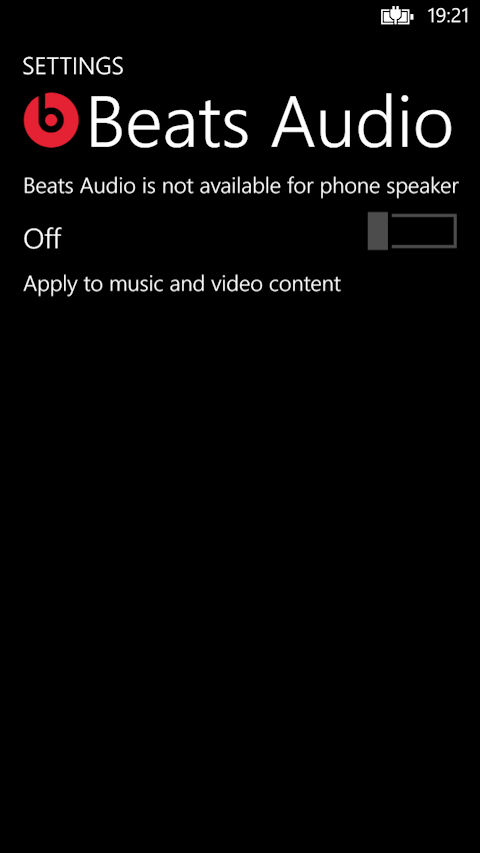
Depending on your taste in music (and how much you enjoy migraines), Beats Audio could be a wonderful concept. But, for others, it will just get in the way of enjoying the music by forcing a specific equalizer setting. Audio purists, who are those most likely to want to tweak music, are going to want a bit more control than this. Of course the Beats branding has implications for the marketing of the device, and it's probably fair to say the reasons for its presence are as much about the associated perception in certain market segments, as they are about audio quality.
HTC has some custom software apps, but none of them cover media, so you'll be using the stock Music+Videos app for all your music needs. This is actually a bonus, because it's very well featured, with history lists, newly added music, and pop up media controls on the lock screen and throughout the UI by tapping on the volume keys.
A related hardware issue that's worth mentioning here is the 16GB internal memory capacity on the 8X. Knock off around 3GB for Windows Phone 8's own usage and you don't have that much space available for music or video, especially if you start loading up on applications and games. 16GB was cutting it close on the second generation Windows Phone 7.5 devices, as we move into Windows Phone 8 having just 16GB on the flagship models seems to be a penny pinching exercise too far. Knock that down to 8GB, as on one of the variants being offered by the AT&T in the US, and the issue is exacerbated.
Internals and Performance
HTC have followed Mcirosoft's recommendations for a Windows Phone 8 platform, so the 8X comes with a Qualcomm Snapdragon S4 system on chip, which has a 1.5 GHz dual-core Krait CPU and Adreno 225 GPU, backed up by 1GB of RAM.
In terms of specifications, this puts the 8X on a par with similar high-end devices both on Windows Phone and on Android. There's no longer a perceived gap between Windows Phone and others, thanks to the increased hardware Microsoft have asked to be used on Windows Phone 8 devices.
Using the benchmarking software WPBench, the HTC 8X picks up a speed score of 230, which is within the margin of error of the Lumia 920's score of 228. It also compares incredibly well with the HTC Titan (97) and HTC Trophy (58) of the two previous generations. Windows Phone 8 is a significant step up in terms of power, and the 8X manages to harness all of that extra capability very well.
The place you most notice it is returning to the Live Tile home screen. The three different sizes of tiles in the new UI all swing in from the side and lay themselves out very quickly, but remain smooth and distinct throughout the move. We love the little touch that when you open an app from a live tile the other live tiles will peel away as if you are turning a page over to go forward in a book, and the back key will see them return by peeling in as if you were turning a page back to check on something. A subtle touch that needs a fair bit of graphical oomph to run well... and it runs well.
Moving between the built-in apps is smooth as well. Yes, you have all the twisting and turning animations to signify movement through your information, but there's no stutter, black screens, or dots travelling across the screen as you wait for one of these apps to open. Everything out of the box is well optimised. When you start to move to third-party apps it gets a little bit more suspect, but here the increased CPU power reduces the wait when compared to Windows Phone 7.5 devices.
The usual sensor suite for a Windows Phone can be found in the 8X, with an accelerometer and digital compass for local positioning, an ambient light sensor to help set the brightness on the screen as required, and a proximity sensor to stop your ear activating the touch screen when in a call.
In terms of communications, the 8X comes with Bluetooth 3.1, Wi-Fi 802.11 a/b/g/n, GPS with Glonass for location, and NFC for close range communication. In terms of cellular connections what you get in the HTC 8X depends on which variant you have:
- International variant: GSM 850/900/1800/1900 MHz, WCDMA 850/900/1900/2100 MHz
- T-Mobile US variant: GSM 850/900/1800/1900 MHz, WCDMA 850/1700/1900/2100 MHz
- AT&T US variant: GSM 850/900/1800/1900 MHz, WCDMA 850/1900/2100 MHz, LTE 700/850/1700/1900MHz
- Verizon US variant: GSM 850/900/1800/1900 MHz, WCDMA 850/900/1900/2100 MHz, CDMA 800/1900 MHz, LTE 700 MHz and wireless charging support
The international variant is notable for its absence of LTE support. HTC are likely looking to keep the cost of the handset down, and, at £100 cheaper than the Nokia Lumia 920 in the UK SIM free market, the international variant of 8X is very competitive in this department. However, while LTE may not be that common outside the US, it's clear that this is going to change, so it is somewhat strange to see a flagship device launching without it. On balance the split strategy for LTE support between variants is probably the right call, but it's probably going to be the last time this applies.
The Verizon variant is notable for the inclusion of wireless charging support (Qi standard). Unlike Nokia, HTC aren't backing this up with a set of matching accessories, so it's a feature that's unlikely to draw much attention. The inclusion of wireless charging is almost certainly a direct request from Verizon, so it'll be interesting to see if this is part of a wider push by Verizon to promote wireless charging.
Conclusion
There's no doubt that the HTC Windows Phone 8X is an impressive smartphone. It's one of the best smartphones seen from HTC, not just with Windows Phone, but over their whole range. It's improved on many of the concepts from the One X series, and it benefits hugely from the Windows Phone OS, which follows it's own design and usage paradigms. Despite one or two minor flaws that are easily forgiven, the HTC 8X is right up there with the equivalent models from Nokia and Samsung.
In fact the 8X is already attempting to reach out to as many potential customers as possible. The roll-out of the Samsung ATIV S is relatively slow, and the decision of Nokia to make the Lumia 920 a network exclusive handset in many regions limits the growth opportunities of the Finnish handset. That leaves the high street retailers wide open to accept HTC as their main Windows Phone handset for the festive period.
It is little things that dull the experience very slightly. 16GB is a touch too small for a leading device, and having the lowest battery capacity of the three main handsets is a worry. It may well be fine the week after you receive the phone, but as the battery becomes less efficient, and you are 20 months into a 24 month contract, the 8X may struggle to make it to the end of the working day without a 'splash and go' recharge.
The 8X is a really nice piece of kit. The design and shaping of the hardware really make it stand out, even more so when you get one of the coloured devices. Windows Phone 8 has removed the rough edges of Microsoft's vision of a mobile platform, and the specifications are high enough that the whole OS can sing and dance without breaking sweat.
A lot of the reaction to the 8X is not going to come down to hardware, though, it's going to come from people's reactions to Windows Phone 8. We'll be looking at the new version of Microsoft's operating system in the near future, but for now know this... HTC have done everything that was asked and expected of them in developing the HTC Windows Phone 8X. While they might only have pushed the boat out in a few areas, and left some areas with a tiny bit of room for improvement, Windows Phone 8 is not going to be a failure because of the HTC 8X.
Continuing coverage
In part 2 of our HTC 8X review, we'll look at the HTC specific software side on the device. We'll also cover the camera in more detail in a separate review part. We'll be covering the manufacturer-agnostic aspects of Windows Phone 8 itself in a separate in-depth review. We will also be doing a more direct comparison of the HTC 8X and Nokia Lumia 920.
Disclosure: Ewan's review handset was loaned by Phones 4u. Phones 4u stocks a number of Windows Phone 8 devices and other mobile phones, including the HTC 8X, in both its retail and online stores.

See Also
Windows Phone 8X by HTC hands-on preview
Gallery: Windows Phone 8X and 8S by HTC
Windows Phone 8X by HTC unveiled in New York
Reviewed by Rafe Blandford, Ewan Spence at





